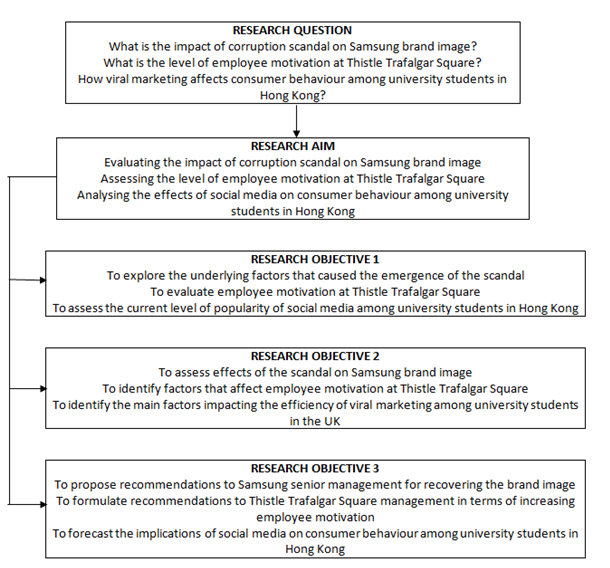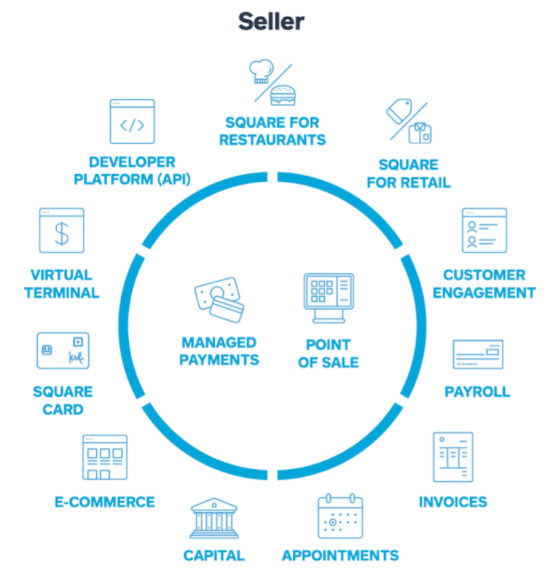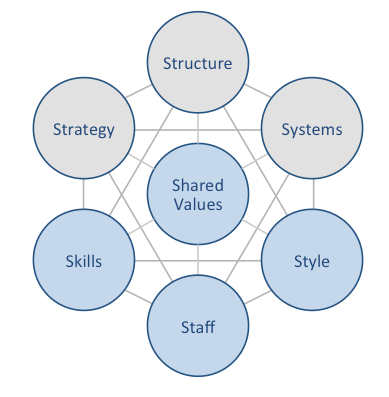
Research background is a brief outline of the most important studies that have been conducted so far presented in a chronological order. Research background part in introduction chapter can be also headed ‘Background of the Study.” Research background should also include a brief discussion of major theories and models related to the research problem. Specifically, when writing research background you can discuss major theories and models related to your research problem in a chronological order to outline historical developments in the research area. When writing research background, you also need to demonstrate how your research relates to what has been done so far in the research area. Research background is written after the literature review. Therefore, literature review has to be the first and the longest stage in the research process, even before the formulation of research aims and objectives, right after the selection of the research area. Once the research area is selected, the literature review is commenced in order to identify gaps in the research area. Research aims and objectives need to be closely associated with the elimination of this gap in the literature. The main difference between background of the study and literature review is that the former only provides general information about what has been done so far in the research area, whereas the latter elaborates and critically reviews previous works. My e-book, The Ultimate Guide to Writing a Dissertation in Business Studies: a step by step assistance offers practical assistance to complete a dissertation with minimum or no stress. The e-book covers all stages of writing a dissertation starting from the selection to the research area to submitting the completed version of the work within the deadline. John Dudovskiy

There are many types of literature review. The choice of a specific type depends on your research approach and design. The following types of literature review are the most popular in business studies: Narrative literature review, also referred to as traditional literature review, critiques literature and summarizes the body of a literature. Narrative review also draws conclusions about the topic and identifies gaps or inconsistencies in a body of knowledge. You need to have a sufficiently focused research question to conduct a narrative literature review Systematic literature review requires more rigorous and well-defined approach compared to most other types of literature review. Systematic literature review is comprehensive and details the timeframe within which the literature was selected. Systematic literature review can be divided into two categories: meta-analysis and meta-synthesis. When you conduct meta-analysis you take findings from several studies on the same subject and analyze these using standardized statistical procedures. In meta-analysis patterns and relationships are detected and conclusions are drawn. Meta-analysis is associated with deductive research approach. Meta-synthesis, on the other hand, is based on non-statistical techniques. This technique integrates, evaluates and interprets findings of multiple qualitative research studies. Meta-synthesis literature review is conducted usually when following inductive research approach. Scoping literature review, as implied by its name is used to identify the scope or coverage of a body of literature on a given topic. It has been noted that “scoping reviews are useful for examining emerging evidence when it is still unclear what other, more specific questions can be posed and valuably addressed by a more precise systematic review.”[1] The main difference between systematic and scoping types of literature review is that, systematic literature review is conducted to find answer to more specific research questions, whereas scoping literature review is conducted to explore more general research…

It is important for you to be able to explain the importance of the research you are conducting by providing valid arguments. Rationale for the study, also referred to as justification for the study, is reason why you have conducted your study in the first place. This part in your paper needs to explain uniqueness and importance of your research. Rationale for the study needs to be specific and ideally, it should relate to the following points: 1. The research needs to contribute to the elimination of a gap in the literature. Elimination of gap in the present literature is one of the compulsory requirements for your study. In other words, you don’t need to ‘re-invent the wheel’ and your research aims and objectives need to focus on new topics. For example, you can choose to conduct an empirical study to assess the implications of COVID-19 pandemic on the numbers of tourists visitors in your city. This might be previously undressed topic, taking into account that COVID-19 pandemic is a relatively recent phenomenon. Alternatively, if you cannot find a new topic to research, you can attempt to offer fresh perspectives on existing management, business or economic issues. For example, while thousands of studies have been previously conducted to study various aspects of leadership, this topic as far from being exhausted as a research area. Specifically, new studies can be conducted in the area of leadership to analyze the impacts of new communication mediums such as TikTok, and other social networking sites on leadership practices. You can also discuss the shortcomings of previous works devoted to your research area. Shortcomings in previous studies can be divided into three groups: a) Methodological limitations. Methodology employed in previous study may be flawed in terms of research design, research approach or sampling. b)…

Research structure is basically an outline of your paper. In your dissertation you are expected to provide the research structure towards the end of introduction chapter. The components of research structure are illustrated in table below: Chapter Components Introduction Introduction of research problem Discussion of research background Research aims and objectives Rationale for the study Research structure Literature review Definitions of main terms Explanation of secondary data search strategy Critical analysis of major models, theoretical frameworks and thoughts Methodology Research process Research philosophy Research design Data collection methods and their application Sampling Findings Primary data presentation Brief discussions Discussions and analysis In-depth discussions and analysis of primary data Comparisons of primary data to secondary data findings Conclusions Discussion of achievement of research aim and objectives Limitations of research Scope for future studies Components of each chapter in research structure The following is a sample of a research structure: Chapter One communicates the purpose and focus of the study and explains the outline of the research. This chapter includes a brief explanation of the research background, and provides rationale for the selection of the research area. Moreover, the first chapter contains explanation of the research aim and objectives, and explains research structure. Chapter Two constitutes a literature review, and accordingly, contains analysis of models and theoretical frameworks that have been previously introduced to the research area. This chapter contains definitions of main terms and explains search strategy for the secondary data. Viewpoints of other authors regarding the research area in general and research problem in particular have been presented in a logical manner in this chapter. Chapter Three addresses methodology. The chapter explains the research process and addresses the issues of research philosophy. Moreover, methodology chapter contains explanation of research…

Formulating research aim and objectives in an appropriate manner is one of the most important aspects of your thesis. This is because research aim and objectives determine the scope, depth and the overall direction of the research. Research question is the central question of the study that has to be answered on the basis of research findings. Research aim emphasizes what needs to be achieved within the scope of the research, by the end of the research process. Achievement of research aim provides answer to the research question. Research objectives divide research aim into several parts and address each part separately. Research aim specifies WHAT needs to be studied and research objectives comprise a number of steps that address HOW research aim will be achieved. As a rule of dumb, there would be one research aim and several research objectives. Achievement of each research objective will lead to the achievement of the research aim. Consider the following as an example: Research title: Effects of organizational culture on business profitability: a case study of Virgin Atlantic Research aim: To assess the effects of Virgin Atlantic organizational culture on business profitability Following research objectives would facilitate the achievement of this aim: Analyzing the nature of organizational culture at Virgin Atlantic by September 1, 2022 Identifying factors impacting Virgin Atlantic organizational culture by September 16, 2022 Analyzing impacts of Virgin Atlantic organizational culture on employee performances by September 30, 2022 Providing recommendations to Virgin Atlantic strategic level management in terms of increasing the level of effectiveness of organizational culture by October 5, 2022 Figure below illustrates additional examples in formulating research aims and objectives: Formulation of research question, aim and objectives Common mistakes in the formulation of research aim relate to the following: 1. Choosing the topic too broadly. This is…

Proposal gives you a chance of finding out if research aims and objectives are valid. Also, it helps to understand if the methods you are planning to use are suitable and feasible. The purpose for writing dissertation proposal is to get it approved by your supervisor to be able to start the actual research. Furthermore, writing dissertation proposal helps you to clarify the direction of your study. The paper needs to be able to communicate the following three critical points to the supervisor: a) You already did your homework in terms of reading a large amount of relevant secondary data in your research area. You will need to briefly mention and discuss the most noteworthy contributions to the research area. b) The research will eliminate a gap in the literature. You will need to highlight the gap in the literature and discuss how the research you are planning to conduct is going to contribute to the existing academic developments. c) Ideally, there is a need for this research from practical point of view. This is not compulsory, but highly welcomed. Being a business study, your work can provide certain benefits in a practical level as well. Total wordcount requirement for a Research Proposal can range between 1500 – 4000 words. The proposal can be prepared in the following format: 1. Title Page 2. Introduction. This part is a brief introduction to the research area with some background information. Some universities require proposal abstract or summary to be included as well. Please refer to the Dissertation Handbook provided by your university. 3. Statement of the Problem. Research problem needs to be explained in a fairly detailed manner in at least 2-3 pages. 4. Aims and Objectives. These need to comply with SMART principle where the acronym stands for specific, measurable, achievable,…

Selecting a research area is the very first step in writing your dissertation. It is important for you to choose a research area that is interesting to you professionally, as well as, personally. Experienced researchers note that “a topic in which you are only vaguely interested at the start is likely to become a topic in which you have no interest and with which you will fail to produce your best work”[1]. Ideally, your research area should relate to your future career path and have a potential to contribute to the achievement of your career objectives. The importance of selecting a relevant research area that is appropriate for dissertation is often underestimated by many students. This decision cannot be made in haste. Ideally, you should start considering different options at the beginning of the term. However, even when there are only few weeks left before the deadline and you have not chosen a particular topic yet, there is no need to panic. There are few areas in business studies that can offer interesting topics due to their relevance to business and dynamic nature. The following is the list of research areas and topics that can prove to be insightful in terms of assisting you to choose your own dissertation topic. Globalization can be a relevant topic for many business and economics dissertations. Forces of globalization are nowadays greater than ever before and dissertations can address the implications of these forces on various aspects of business. Following are few examples of research areas in globalization: A study of implications of COVID-19 pandemic on economic globalization Impacts of globalization on marketing strategies of beverage manufacturing companies: a case study of The Coca-Cola Company Effects of labour migration within EU on the formation of multicultural teams in UK organizations A study into advantages…

Square CSR programs and initiatives mainly focus on four key priority areas – Climate Action, Social Impact, Employees and Culture, and Corporate Governance. These initiatives are led by Neil Jorgensen, Global Environmental, Social, and Governance Lead at Square. Square Supporting Local Communities Square has invested USD 100 million in minority and underserved communities The financial unicorn assists some local communities in the US to preserve their local culture and deal with other most pressing issues. In many offices there are active volunteer communities, referred to volunteams that undertake various projects to support local communities Square and Gender Equality and Minorities Square invests in employee resource groups such as Black Squares Association, LatinX Community, LGBTQ group, and others in order to create an inclusive environment The majority 54,1% of US employees of The fintech are white people, as illustrated in Figure 1 below: Figure 1 Race and ethnicity of Square Inc. employees in US[1] Energy Consumption by Square Square launched Bitcoin Clean Energy Investment Initiative, USD 10 million investment to help accelerate renewable energy adoption in bitcoin mining. The payments company is planning to evaluate and explore clean energy options, working closely with its key provider partners. Carbon Emissions by Square In 2020 the total carbon footprint for Square totalled to 247,900 tCO2e. The Figure 2 below illustrates the share of carbon emissions by operations: Figure 2 Square Inc. total carbon emissions in 2020[2] The financial services and digital payments company has aimed to be zero carbon for operations by 2030. Other CSR Initiatives and Charitable Donations by Square Leads Program offered to managers at all levels is designed to develop leadership skills and competencies The finance sector disruptor fully pays parental leave globally, caregiving leave to US employees In UK Square partnered with The Entrepreneurial…

Square ecosystem represents a growing ecosystem of financial services. Ecosystem of Square can be divided into two groups: seller ecosystem and cash ecosystem. Square seller ecosystem is a cohesive commerce ecosystem that helps its sellers start, run, and grow their businesses. As illustrated in Figure 1 below, the core services for sellers are managed payments and points of sales products and services. Specific functionalities that contribute to these services include customer engagement platform, payroll invoices services, functionality to make appointments and capital management tools. Moreover, e-commerce and developer platforms, as well as, virtual terminal are important components of Square ecosystem on the Seller front. Figure 1 Square Seller products and services Square cash ecosystem, represented by Cash App comprises a wide range of financial products and services that are designed to help individuals manage their money. These include a cash card, instant discounts tool Boost. The strongest feature of Cash App that has no analogue in the market is the functionality to purchase Bitcoints and stocks in a simple, secure and hassle-free manner. Figure 2 Square Cash App functionalities The financial services and digital payments company is increasing the linkage between its seller and cash ecosystem in order to from strengthen its position in the market. For example, employers with seller account can pay their employees from seller revenues the next business day using Instant Payments feature when employees use Cash App. There is still room for growth of Square ecosystem on both fronts – Seller and Cash App. Apart from connecting the both ecosystems. The finance sector disruptor can also scale each of them, as well as, engage in optimised cross-selling. Moreover, the developer platform can play an instrumental role in expanding the ecosystem for Square, through exposing Application Program Interface (API) to third party developers to adjust it…

Square McKinsey 7S model is intended to illustrate how seven elements of business can be aligned to increase effectiveness. The framework divides business elements into two groups – hard and soft. Strategy, structure and systems are considered hard elements, whereas shared values, skills, style and staff are soft elements. According to Square McKinsey 7S model, there is a strong link between elements and a change in one element causes changes in others. Moreover, shared values are the most important of elements because they cause influence other elements to a great extent. McKinsey 7S model Hard Elements in Square McKinsey 7S Model Strategy Square business strategy is based on principles of simplifying financial transactions and developing an ecosystem of financial products and services. The financial services platform has two types of ecosystem – seller ecosystem and cash ecosystem. Square systematically expands both ecosystems with addition of new financial products and services that simplify processes and challenge the status quo. Structure Square organizational structure is highly dynamic, reflecting the rapid expansion of the range of financial products and services offered by the finance sector disruptor. Although it is difficult to frame Square organizational culture into any category due to the complexity of the business, it is closer to flat organizational structure compared to known alternatives. Specifically, co-founder and CEO Jack Dorsey has very little tolerance for bureaucracy and formality in business processes. Moreover, Dorsey believes in providing independence to teams and maintain the team sizes small. All of these are reflected in Square organizational structure. Systems Square Inc. business operations depend on a wide range of systems. These include employee recruitment and selection system, team development and orientation system, transaction processing systems and others. Moreover, customer relationship management system, business intelligence system and knowledge management system is also important…
